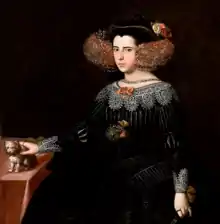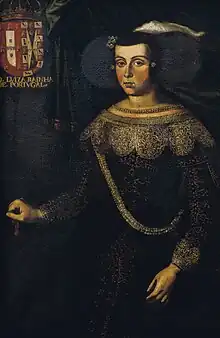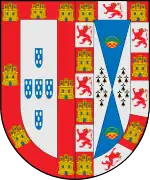Luisa de Guzmán
Luisa María Francisca de Guzmán y Sandoval (Portuguese: Luísa Maria Francisca de Gusmão;[1] 13 October 1613 – 27 February 1666) was Queen of Portugal as the spouse of King John IV, the first Braganza ruler. She was the mother of two kings of Portugal (Afonso VI and Peter II) and a queen of England (Catherine of Braganza).[2] She served as regent of Portugal from 1656 until 1662.[3]
| Luisa de Guzmán | |||||
|---|---|---|---|---|---|
 Portrait attributed to Alonso Cano, 1632 | |||||
| Queen consort of Portugal | |||||
| Tenure | 1 December 1640 – 6 November 1656 | ||||
| Queen Regent of Portugal | |||||
Regency | 6 November 1656 – 22 June 1662 | ||||
Monarch | |||||
| Born | 13 October 1613 Sanlúcar, Spain | ||||
| Died | 27 February 1666 (aged 52) Lisbon, Portugal | ||||
| Burial | |||||
| Spouse | João IV of Portugal | ||||
| Issue | |||||
| |||||
| House | Medina Sidonia | ||||
| Father | Manuel de Guzmán y Silva, 8th Duke of Medina Sidonia | ||||
| Mother | Juana de Sandoval y la Cerda | ||||
| Religion | Roman Catholicism | ||||
| Signature |  | ||||
Biography
Early life
Luisa was Spanish by birth, the daughter of Manuel Pérez de Guzmán y Silva, 8th Duke of Medina Sidonia, and Juana Lorenza Gomez de Sandoval y de la Cerda.[1] Her paternal grandfather was Alonso de Guzmán, "El Bueno", while her paternal great-grandmother was Ana de Mendoza y de Silva, Princess of Éboli. Through her mother, she was also a descendant of Isabel of Portugal, Lady of Viseu, the illegitimate daughter of King Ferdinand I.
She married a high ranking Portuguese noble, John, 8th Duke of Braganza, in 1633, during the period of the Iberian Union.[4][5]
Restoration War
Despite her Spanish roots, Luisa guided her husband's policies during the Portuguese revolution against Habsburg Spain of 1640.[6] She is considered the main influence[2][5] behind his acceptance of the Portuguese throne.[7][8] It is said that being warned of the dangers of becoming queen of a country that was to face Spain's might, she pronounced the famous words:
Antes Rainha um dia que Duquesa toda a vida.
Rather Queen for a day than Duchess all my life.
In some sources, this is quoted as for an hour instead of for a day.
When she was made aware of a failed attempt to murder the King in 1641, she is said to have been one of the members of the Corte, which supported the execution of nobles like the Duke of Caminha.
Regency

In 1656, she was named Regent of the Kingdom after her husband's death and during the minority of her son Afonso VI.[9][10]
Luisa was politically astute[11] and mainly responsible for the diplomatic success of the new alliance with England.[12][13] Her daughter Catherine married Charles II of England.[14]
Afonso was considered mentally unfit for governing.[15] In addition to lacking intellect, he exhibited wild and disruptive behavior.[9][16] In 1662, after the king terrorized Lisbon at night alongside his favorites,[17][18] Luisa and her council responded by banishing some of the king's companions that were associated with the raids.[18] Angered, Afonso took power with the help of Castelo-Melhor and Luisa's regency came to an end.[19][20] She subsequently retired to a convent,[21][1] where she died in 1666.[22]
Issue

- Infante Teodósio, Prince of Brazil (8 February 1634 – 13 May 1653) died unmarried.
- Ana of Braganza (21 January 1635) died at birth.
- Infanta Joana, Princess of Beira (18 September 1635 – 17 November 1653) died unmarried.
- Catherine of Braganza (25 November 1638 – 31 December 1705) married Charles II of England and had no surviving issue.
- Manuel of Portugal (6 September 1640) died at birth.
- Afonso VI of Portugal (21 August 1643 – 12 September 1683) married Maria Francisca of Savoy.
- Pedro II of Portugal (26 April 1648 – 9 December 1706) married firstly Maria Francisca of Savoy, had issue; married secondly Maria Sophia of Neuburg, had issue.
Ancestry
| Ancestors of Luisa de Guzmán | |||||||||||||||||||||||||||||||||||||||||||||||||||||||||||||||||||||||||||||||||||||||||||||||||||||||||||||||||||||||||||||||||||||||||||||||||||||||||||||||||||||||||||||||||||||||||||||||||||||||||||||||||||||||||||||||||||||||||||||||||||||||||||||||||||||||||||||||||||||||||
|---|---|---|---|---|---|---|---|---|---|---|---|---|---|---|---|---|---|---|---|---|---|---|---|---|---|---|---|---|---|---|---|---|---|---|---|---|---|---|---|---|---|---|---|---|---|---|---|---|---|---|---|---|---|---|---|---|---|---|---|---|---|---|---|---|---|---|---|---|---|---|---|---|---|---|---|---|---|---|---|---|---|---|---|---|---|---|---|---|---|---|---|---|---|---|---|---|---|---|---|---|---|---|---|---|---|---|---|---|---|---|---|---|---|---|---|---|---|---|---|---|---|---|---|---|---|---|---|---|---|---|---|---|---|---|---|---|---|---|---|---|---|---|---|---|---|---|---|---|---|---|---|---|---|---|---|---|---|---|---|---|---|---|---|---|---|---|---|---|---|---|---|---|---|---|---|---|---|---|---|---|---|---|---|---|---|---|---|---|---|---|---|---|---|---|---|---|---|---|---|---|---|---|---|---|---|---|---|---|---|---|---|---|---|---|---|---|---|---|---|---|---|---|---|---|---|---|---|---|---|---|---|---|---|---|---|---|---|---|---|---|---|---|---|---|---|---|---|---|---|---|---|---|---|---|---|---|---|---|---|---|---|---|---|---|---|---|---|---|---|---|---|---|---|---|---|---|---|---|---|---|---|
| |||||||||||||||||||||||||||||||||||||||||||||||||||||||||||||||||||||||||||||||||||||||||||||||||||||||||||||||||||||||||||||||||||||||||||||||||||||||||||||||||||||||||||||||||||||||||||||||||||||||||||||||||||||||||||||||||||||||||||||||||||||||||||||||||||||||||||||||||||||||||
References
- "Luísa Gusmão", Dicionário [Dictionary] (in Portuguese), Arq net.
- Livermore 1969, p. 173.
- Ames 2000, p. 18.
- Stephens 1891, p. 304.
- McMurdo 1889, p. 363.
- Stephens 1891, p. 305.
- Stephens 1891, p. 306.
- McMurdo 1889, p. 367.
- McMurdo 1889, p. 408.
- Dyer 1877, p. 340.
- Davidson 1908, p. 14.
- Dyer 1877, p. 341.
- Ames 2000, p. 29.
- Davidson 1908, p. 96.
- Marques 1976, p. 331.
- Livermore 1969, p. 185.
- McMurdo 1889, p. 414.
- Livermore 1969, p. 189.
- Marques 1976, p. 332.
- Stephens 1891, p. 331.
- McMurdo 1889, p. 417.
- Ames 2000, p. 30.
Sources
- Ames, Glenn Joseph (2000). Renascent Empire?: The House of Braganza and the Quest for Stability in Portuguese Monsoon Asia, ca. 1640-1683. Amsterdam: Amsterdam University Press. ISBN 9053563822.
- Davidson, Lillias Campbell (1908). Catherine of Bragança, infanta of Portugal, & queen-consort of England.
- Dyer, Thomas Henry (1877). Modern Europe Vol III.
- Livermore, H.V. (1969). A New History of Portugal. Cambridge University Press. ISBN 9780521095716.
- Marques, Antonio Henrique R. de Oliveira (1976). History of Portugal.
- McMurdo, Edward (1889). The history of Portugal, from the Commencement of the Monarchy to the Reign of Alfonso III. London: Sampson Low, Marston, Searle, & Rivington. Retrieved 25 October 2023.
- Stephens, H. Morse (1891). The Story of Portugal. New York: G. P. Putnam's Sons. Retrieved 25 October 2023.